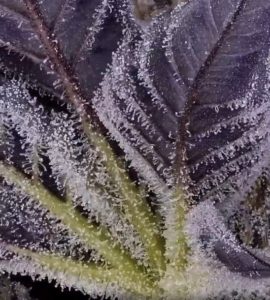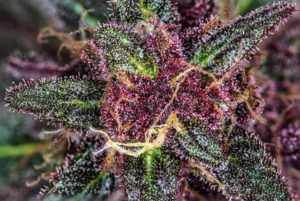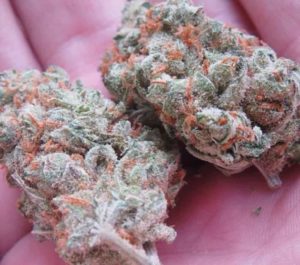Trichomes. You have read about them and you have heard people ‘in the know’ talking about them, but, what the heck are trichomes?
According to Wikipedia, plant trichomes have many different features that vary between both species of plants and organs of an individual plant. These features affect the subcategories that trichomes are placed into. Some defining features include:
- Unicellular or multicellular
- Straight (upright with little to no branching)
- Spiral (corkscrew-shaped)
- Hooked (curved apex)
- Presence of cytoplasm
- Glandular (secretory) vs. Eglandular
- Tortuous
- Simple (unbranched and unicellular)
- Peltate (scale-like)
- Stellate (star-shaped)
- Adaxial vs. abaxial [referring to whether trichomes are present, respectively, on the upper surface (adaxial) or lower surface (abaxial) of a leaf or other lateral organ]
In a model organism, C. salvifolius, there are more adaxial trichomes present on this plant because this surface suffers from more UV, solar irradiance light stress than the abaxial surface.
Trichomes can protect the plant from a large range of detriments, such as UV light, insects, transpiration, and freeze intolerance.
Cannabis Trichomes
 Looking at a multi-colored, frost covered, cannabis flower/bud often causes a cannabis aficionado to pause in anticipatory wonder. For those who haven’t yet learned their way around a cannabis plant, one question comes up frequently: what is the ‘frosty’ stuff?
Looking at a multi-colored, frost covered, cannabis flower/bud often causes a cannabis aficionado to pause in anticipatory wonder. For those who haven’t yet learned their way around a cannabis plant, one question comes up frequently: what is the ‘frosty’ stuff?
If you zoom in on those tiny little crystals you will notice they tend to be shiny, sticky, and ‘stinky’ (or aromatic, if you prefer). What you are looking at are trichomes. In addition to the characteristics described above, trichomes are a cannabis or hemp plants’ way of producing cannabinoids, terpenes and flavonoids: the “things” which makes cannabis plants so fascinating.
Cannabis Trichomes, what the heck are trichomes?
Many plant species produce trichomes, which can take on different forms (straight, spiral or hooked) and can serve different purposes. With cannabis plants, the trichomes help to protect the plant from insects, animals (the trichomes give the plant a taste bitter), UV rays and wind.
The different types of trichomes on cannabis
As noted above, trichomes exist in many shapes and sizes. The three that appear most often on cannabis plants are: bulbous trichomes, capitate sessile trichomes and capitate-stalked trichomes.
- Bulbous trichomes: 10-15 micrometers. These appear on the entire plant
- Capitate sessile trichomes: 15-20 micrometers (slightly larger than the bulbous trichome) and contain both a head and a stalk
- Capitate-stalked trichomes: 50-100 micrometers (big enough to be seen by the naked eye). These consist of a stalk (epidermal and hypodermic cells) which build up to a basal cell that attaches to a gland head. The gland head is the epicenter for cannabinoid and terpenoid synthesis.
While all three types of trichomes produce cannabinoids, it is the capitate-stalked trichomes which, due to their size, produce the highest concentration of cannabinoid resin.
Trichrome Production and Lifecyle
When cannabis plants are exposed to 12 hours of light and 12 hours of darkness (for indoor production) or, on the day after Summer Solstice (when it’s one second less light than it was the day before), they start to bloom. Cannabis plant geneticists call this “auto-flowering”.
Blooming triggers cannabinoid synthesis in the trichomes which culminates with the gland head metabolizing vacuoles and plastids into the precursors of the various cannabinoids found in that specific strain of cannabis. In other words, when the plant starts to bloom, the trichomes begin their ‘journey’ into individual pods of ‘resin’.
The genetic profile of any given cannabis strain drives the rate and concentration of trichome production. The most impactful variable on the concentrations of cannabinoids and/or terpenes is UV light. Growers know that when cannabis plants are exposed to the broadest UV spectrum, the plants, typically, produce higher concentrations of cannabinoids. The other variable is the strain itself, as many strains respond to UV spectrums differently.
Since the trichome’s and plant’s lifecycles are linked, monitoring trichome maturation is a time-testing way to monitor the plant’s lifecycle stage. In other words, the plant is ready to harvest when the trichomes are completely ‘mature’.
What do ‘mature’ trichomes look like? When the plant and trichomes are young, you’ll see mostly clear ‘crystals’. People say cannabis plants look “sparkly”; this is because of the light refracting off all the translucent trichomes on the plant. As the plant matures, the trichome change from clear crystals lying flat on the plant (almost like a fur) to a cloudy white. The other phenomena which is occurring is the trichomes begin to ‘stand up’. In the final, mature, phase, the trichomes are all standing fully erect and have changed from a cloudy white color to a golden or amber.
It is at this stage that the plants are ‘ripe’ and ready for harvest.
Another Method of Determining Harvest Time
 For the sake of completing the conversation, there’s another measurement which can also be used to tell if a plant is ready for harvest, and that is: how old are the plants?
For the sake of completing the conversation, there’s another measurement which can also be used to tell if a plant is ready for harvest, and that is: how old are the plants?
All cannabis plants have a ‘pre-determined’ number of days of growth and ripening coded into their genetics. Typically, grow cycles are 90 to 120 days, starting from when the lights are “flipped” to 12 hours on/12 hours off (for indoor) OR the day after Solstice (for outdoor).
For example, if you are growing outdoors and the stain has a 90 day grow cycle, then, by the calendar, 90 days from June 22nd means that on or about September 22nd the trichomes on those plants SHOULD be completely mature.
Due to environmental and grow technique variables (indoor versus outdoor) trichome coloration is the standard for determining harvest time for most strains.
Trichome Farming
Trichrome farming is the process of focusing on maximizing specific types of trichomes by growing strains rich with those varieties. Long time growers are very familiar with the concept of ‘growing with intention’. In fact, many growers of medicinal cannabis work diligently to propagate strains which are rich in one trichome profile or another.
Cannabis Processing
Clearly, trichomes are critical to the output of carefully grown cannabis, and as such, processing cannabis is also a ‘trichome-centric’ activity. Processing cannabis creates opportunities to capture or extract individual trichomes from the biomass of the cannabis plant.
21st century industrial cannabis trimmers are constructed like a tumble-dry dryer, except, the inside of the ‘tumbler’ is built like a cheese-grater. As the cannabis plant is fed into the trimmer, the machine bounces the biomass around shaking off trichomes (Gasp! No!) while ‘trimming’ cannabis buds to a consistent size and shape.
 Next time you open a container of processed cannabis, notice how all the buds are similar is size and shape AND that there are, unless it’s been hand-trimmed, NO trichomes sitting on the bud – it’s like the bud had a very tight haircut.
Next time you open a container of processed cannabis, notice how all the buds are similar is size and shape AND that there are, unless it’s been hand-trimmed, NO trichomes sitting on the bud – it’s like the bud had a very tight haircut.
The trichomes which got ‘trimmed’ off the plant are gathered up in a catch-bin for processing (if you hand-trim cannabis, you can sift your buds and shake off “kief”, which are these same loose trichomes.
The biomass which is left over from the trimming process, including stems, leaves and small buds, can then be processed, under pressurized systems, to create concentrates and oils.
Bottom Line: trichomes are important to both cannabis plants and people’s health!
Conclusion
To learn more about trichomes, take Happy Travelers Tours Cannabis Dispensary Tour and get a behind-the-scenes tour of an indoor production facility or Book our MountainTop Grow Tour and get up-close-and-personal with Cannabis Plants. Book your Tour Today!